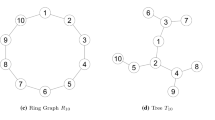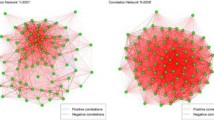Abstract
The understanding of how a networked system behaves and keeps its topological features when facing element failures is essential in several applications ranging from biological to social networks. In this context, one of the most discussed and important topics is the ability to distinguish similarities between networks. A probabilistic approach already showed useful in graph comparisons when representing the network structure as a set of probability distributions, and, together with the Jensen-Shannon divergence, allows to quantify dissimilarities between graphs. The goal of this article is to compare these methodologies for the analysis of network comparisons and robustness.
Access this chapter
Tax calculation will be finalised at checkout
Purchases are for personal use only
Similar content being viewed by others
Notes
- 1.
Higher degree nodes have a bigger probability of getting new connections.
- 2.
The nodes fail in decreasing order of centrality.
References
Bunke, H.: Recent developments in graph matching. In: Proceedings of the 15th International Conference on Pattern Recognition, vol. 2 (2000). http://dx.doi.org/10.1109/ICPR.2000.906030
Dehmer, M., Emmert-Streib, F., Kilian, J.: A similarity measure for graphs with low computational complexity. Appl. Math. Comput. 182(1), 447–459 (2006)
Rodrigues, L., Travieso, G., Boas, P.R.V.: Characterization of complex networks: a survey of measurements. Adv. Phys. 56(1), 167–242 (2006)
Schaeffer, S.E.: Survey: graph clustering. Comput. Sci. Rev. 1(1), 27–64 (2007)
Bai, L., Hancock, E.R.: Graph kernels from the Jensen-Shannon divergence. J. Math. Imaging Vis. 47(1–2), 60–69 (2013)
Schieber, T.A., Ravetti, M.G.: Simulating the dynamics of scale-free networks via optimization. PLoS ONE 8(12), e80783 (2013)
Babai, L.: Graph isomorphism in quasipolynomial time. Arxiv, January 2016. http://arxiv.org/abs/1512.03547
Carpi, L.C., Saco, P.M., Rosso, O.A., Ravetti, M.G.: Structural evolution of the tropical pacific climate network. Eur. Phys. J. B 85(11), 1–7 (2012). http://dx.doi.org/10.1140/epjb/e2012-30413-7
Schieber, T.A., Carpi, L., Frery, A.C., Rosso, O.A., Pardalos, P.M., Ravetti, M.: Information theory perspective on network robustness. Phys. Lett. A 380(3), 359–364 (2016)
Schieber, T.A., Carpi, L., Ravetti, M., Pardalos, P.M., Massoler, C., Diaz Guilera, A.: A size independent network difference measure based on information theory quantifiers (2016, Unpublished)
Carpi, L.C., Rosso, O.A., Saco, P.M., Ravetti, M.: Analyzing complex networks evolution through information theory quantifiers. Phys. Lett. A 375(4), 801–804 (2011). http://www.sciencedirect.com/science/article/pii/S037596011001577X
Newman, M.E.J., Strogatz, S.H., Watts, D.J.: Random graphs with arbitrary degree distributions and their applications. Phys. Rev. E 64, 026118 (2001)
Deza, M.M., Deza, E.: Encyclopedia of Distances, p. 590. Springer, Heidelberg (2009)
Lewis, T.G.: Network Science: Theory and Applications. Wiley Publishing, Hoboken (2009)
Erdös, P., Rényi, A.: On random graphs. Publ. Math. 6(290), 290–297 (1959)
Albert, R., Barabási, A.: Statistical mechanics of complex networks. Rev. Mod. Phys. 74, 47–97 (2002). http://arxiv.org/abs/cond-mat/0106096
Frank, O., Strauss, D.: Markov graphs. J. Am. Stat. Assoc. 81(395), 832–842 (1986)
Watts, D.J., Strogatz, S.H.: Collective dynamics of small-world networks. Nature 393(1), 440–442 (1998)
Cox, T.F., Cox, T.F.: Multidimensional Scaling, 2nd edn. Chapman and Hall/CRC, Boca Raton (2000). http://www.amazon.com/Multidimensional-Scaling-Second-Trevor-Cox/dp/1584880945
Arulselvan, A., Commander, C.W., Elefteriadou, L., Pardalos, P.M.: Detecting critical nodes in sparse graphs. Comput. Oper. Res. 36(7), 2193–2200 (2009). http://dx.doi.org/10.1016/j.cor.2008.08.016
Dinh, T.N., Xuan, Y., Thai, M.T., Pardalos, P.M., Znati, T.: On new approaches of assessing network vulnerability: hardness and approximation. IEEE/ACM Trans. Netw. 20(2), 609–619 (2012)
Walteros, J.L., Pardalos, P.M.: A decomposition approach for solving critical clique detection problems. In: Klasing, R. (ed.) SEA 2012. LNCS, vol. 7276, pp. 393–404. Springer, Heidelberg (2012)
Kunegis, J.: KONECT - the Koblenz network collection. In: Proceedings of International Web Observatory Workshop (2013)
Isella, L., Stehlé, J., Barrat, A., Cattuto, C., Pinton, J.F., den Broeck, W.V.: What’s in a crowd? analysis of face-to-face behavioral networks. J. Theor. Biol. 271(1), 166–180 (2011)
Iyer, S., Killingback, T., Sundaram, B., Wang, Z.: Attack robustness and centrality of complex networks. PLoS ONE 8(4), e59613 (2013)
Train bombing network dataset - KONECT, January 2016
Hayes, B.: Connecting the dots. Can the tools of graph theory and social-network studies unravel the next big plot? Am. Sci. 94(5), 400–404 (2006)
Lin, J.: Divergence measures based on the Shannon entropy. IEEE Trans. Inf. Theory 37(1), 145–151 (1991)
Opsahl, T., Agneessens, F., Skvoretz, J.: Node centrality in weighted networks: generalizing degree and shortest paths. Soc. Netw. 32(3), 245–251 (2010)
Acknowledgments
Research is partially by supported by the Laboratory of Algorithms and Technologies for Network Analysis, National Research University Higher School of Economics, CNPq and FAPEMIG, Brazil.
Author information
Authors and Affiliations
Corresponding author
Editor information
Editors and Affiliations
Rights and permissions
Copyright information
© 2016 Springer International Publishing Switzerland
About this paper
Cite this paper
Schieber, T., Ravetti, M., Pardalos, P.M. (2016). A Review on Network Robustness from an Information Theory Perspective. In: Kochetov, Y., Khachay, M., Beresnev, V., Nurminski, E., Pardalos, P. (eds) Discrete Optimization and Operations Research. DOOR 2016. Lecture Notes in Computer Science(), vol 9869. Springer, Cham. https://doi.org/10.1007/978-3-319-44914-2_5
Download citation
DOI: https://doi.org/10.1007/978-3-319-44914-2_5
Published:
Publisher Name: Springer, Cham
Print ISBN: 978-3-319-44913-5
Online ISBN: 978-3-319-44914-2
eBook Packages: Computer ScienceComputer Science (R0)




